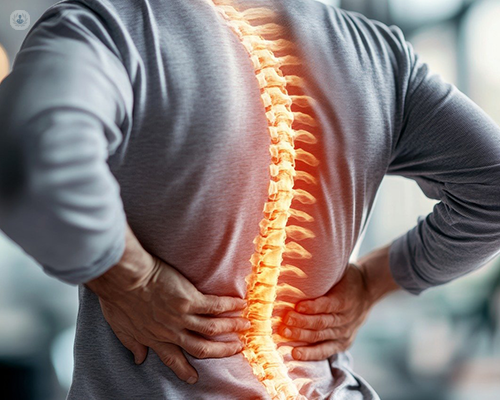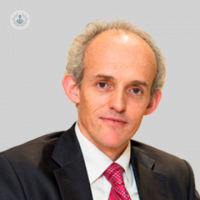Discectomy: All about the procedure
Escrito por:When back pain or related symptoms are caused by a herniated disc that is pressing on nearby nerves, a surgical procedure known as a discectomy may be recommended.
Mr Caspar Aylott, renowned consultant spinal surgeon at The UK Spine Centre, provides an expert insight into a discectomy, answering key questions regarding surgery, recovery expectations, and success rates.

Why would I need a discectomy?
A discectomy is primarily performed to treat herniated discs in the spine. When the soft inner material of the spinal disc pushes through a tear in the disc’s outer layer, it can compress nearby nerves. This compression often leads to symptoms such as pain, numbness, or weakness.
Conservative treatments, including physical therapy, medications and spinal injections, are usually tried first to treat the issue. However, if these treatments fail to relieve symptoms and the patient’s quality of life is significantly impacted, a discectomy may be required.
A discectomy is a targeted surgical procedure that removes the part of a herniated or damaged intervertebral disc that is compressing nearby nerves in the spine. This helps to relieve the associated pain and neurological symptoms.
How is a discectomy performed?
A minimally invasive discectomy (also known as a microdiscectomy) is the most common and advanced surgical approach. This procedure is typically performed under general anaesthesia, with the patient positioned face down on a surgical table. A surgical marker is used to identify the exact location of the herniated disc based on prior imaging.
During the operation, a small incision (usually less than 3 cm in length) is made in the patient’s back at the site of the herniated disc. Using fluoroscopy or endoscopy, the surgeon will then insert tubular retractors through this incision to gently push aside the muscles and tissue, creating a pathway to the spine. This minimally invasive technique avoids cutting through muscles, which helps to reduce the trauma to the surrounding tissues.
The surgeon will insert specialised micro-instruments through the tubular retractors and access the vertebrae to locate the affected disc. Using the surgical instruments, the surgeon will then carefully remove the portion of the disc that is compressing on the nerve. With a microdiscectomy, only the damaged part of the disc will be removed, preserving as much of the healthy disc as possible.
Lastly, the instruments and tubular retractor will be removed. The surgeon will close the small incision using sutures, and a sterile dressing will be applied to the site.
What is the recovery time after a discectomy?
A microdiscectomy is often performed as an outpatient procedure, meaning that most patients go home the same day. Some discomfort is common in the days following surgery, but this can be controlled with prescribed pain medications.
There is a small 2-3% risk of complications with surgery such as nerve injury, spinal fluid leak, infection, ongoing or worse symptoms, bleeding, blood clots, or anaesthetic problems which are manageable. More serious complications are exceedingly rare.
Most patients will resume light activities, including desk jobs, within two to four weeks of the procedure. However, more physically-demanding jobs will need a longer recovery period.
Full recovery will take between 6 to 12 weeks. However, heavy lifting, strenuous activities, and high-impact sports should be avoided for several months to prevent re-injury.
Will I need physiotherapy after a discectomy?
Yes, physiotherapy is typically recommended as part of the recovery process after a discectomy, to restore strength and flexibility, improve range of motion, and reduce the risk of re-injury. Most patients will begin their physiotherapy programme within a few weeks after surgery once the initial healing process has begun.
What is the success rate of a discectomy?
A discectomy has a high success rate in relieving nerve compression and associated symptoms, particularly when performed for the right patients. Around 90-95% of patients will experience significant relief from pain after a discectomy.
At The UK Spine Centre, the combination of keyhole surgery with special regional anaesthesia is unique, and it allows our patients to be up and about within a few hours of the surgery and able to leave the hospital on the same day. We often treat professional athletes who are able to return to professional sport after a microdiscectomy.
If you would like to book an appointment with Mr Caspar Aylott, head on over to his Top Doctors profile today.


